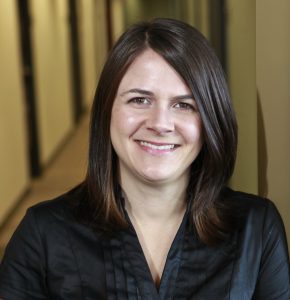
Kasey Windels, Ph.D.
Associate Professor - Department of Advertising
Office: 3050 Weimer
Phone: 352-294-1398
Email: kwindels@ufl.edu
Kasey Windels, Ph.D.
Associate Professor - Department of Advertising
Kasey Windels is an associate professor in the Department of Advertising at the University of Florida College of Journalism and Communications.
Before joining UF in 2018, Windels was an associate professor of digital advertising at Louisiana State University. Prior to LSU, she was an assistant professor at DePaul University.
Her research interests center on the advertising agency itself, with a specific interest on creativity within the advertising agency. Windels has earned five research awards in her career, including best article of the year for both a journal and a major advertising conference. Her work has been featured in the Journal of Advertising, International Journal of Advertising, and Journal of Business Ethics.
Areas of Expertise
Advertising Campaign, Research and Strategy, Copywriting, Creative Leadership and Direction, Creative Strategy
Education
Ph.D., University of Texas, Austin
M.A., University of Texas, Austin
B.A., Louisiana State University
News
- Three UFCJC Faculty Included in ScholarGPS 2024 Top Scholars Listings (June 3, 2025)
- UFCJC Advertising Faculty, Doctoral Students and Alumni Recognized at 2025 AAA Annual Conference (March 12, 2025)
- How Neoliberal Ideas Shaped Public Service Announcements: A Three-Decade Analysis (December 31, 2024)
- UFCJC Students Experience “Transformative Journey” in Cannes (July 22, 2024)
- Study: PSA Content Increasingly Employs Neoliberal Discourses (January 10, 2024)
- All News About Kasey Windels →
Publications
Refereed Journal Articles
Windels, K., Mueller, S., Xiaofan, W., & Chen, H. (2025). Agent of Your Own Destiny: How Neoliberal Discourses Permeate Award Winning Public Service Advertisements. Journal of Advertising. DOI: 10.1080/00913367.2023.2291474
DeGregorio, F., & Windels, K. (2021). Are Advertising Agency Creatives More Creative Than Anyone Else? An Exploratory Test of Competing Predictions. Journal of Advertising, 50(2), 207-216. DOI: 10.1080/00913367.2020.1799268
Windels, K., & Porter, L. (2020). Examining Consumers’ Recognition of Native and Banner Advertising on News Website Home Pages. Journal of Interactive Advertising, 21(1), 1-16. DOI: 10.1080/15252019.2019.1688737
Stuhlfaut, M. W., & Windels, K. (2019). Altered states: The effects of media and technology on the creative process in advertising agencies. Journal of Marketing Communications, 25(1), 1-27.
Windels, K., Heo, J., Jeong, Y., Porter, L., Jung, A., & Wang, R. (2018). My friend likes this brand: Do ads with social context attract more attention on social networking sites?. Computers in Human Behavior, 84, 420-429.
Windels, K., & Stuhlfaut, M. (2018). New Advertising Agency Roles in the Ever-Expanding Media Landscape. Journal of Current Issues & Research in Advertising, 39(3), 226-243.
Windels, K., & Stuhlfaut, M. W. (2017). Teaching Creativity: Experimental Evidence of Three Strategies for Teaching Industry Standards for Creative Excellence. Journal of Advertising Education, 21(1), 13-25. DOI: 10.1177/109804821702100105
Chu, S., Windels, K., & Kamal, S. (2016). The influence of self-construal and materialism on social media intensity: a study of China and the United States. International Journal of Advertising, 35(3), 569-588.
Stuhlfaut, M. W., & Windels, K. (2015). The creative code: A moderator of divergent thinking in the development of marketing communications. Journal of Marketing Communications, 21(4), 241-259.
Windels, K., & Stuhlfaut, M. W. (2014). Confined creativity: The influence of creative code intensity on risk taking in advertising agencies. Journal of Current Issues & Research in Advertising, 35(2), 147-166.
Windels, K., Mallia, K. L., & Broyles, S. J. (2013). Soft skills: The difference between leading and leaving the advertising industry?. Journal of Advertising Education, 17(2), 17-27.
Mallia, K. L., Windels, K., & Broyles, S. J. (2013). The fire starter and the brand steward: An examination of successful leadership traits for the advertising-agency creative director. Journal of Advertising Research, 53(3), 339-353.
Stuhlfaut, M. W., & Windels, K. (2012). Measuring the organisational impact on creativity: The creative code intensity scale. International Journal of Advertising, 31(4), 795-818.
Research
Windels examines the advertising industry in her research. She is interested in how agencies can encourage employee creativity. She is also interested in practitioner perspectives on how advertising works and helping to bridge the gap between industry and academia. Her latest research systematically reviews the academic literature in which advertising professionals are the participants or informants, assessing what we have learned from advertising professionals.
Courses
- ADV 3008 - Principles of Advertising - Spring 2026 (PDF)
- ADV 4101 - Copywriting and Visualization - Spring 2026 (PDF)
- ADV 4101 - Copywriting and Visualization - Fall 2025 (PDF)
- ADV 4101 - Copywriting and Visualization - Fall 2025 (PDF)
- RTV 4930 - Creative Thinking and Storytelling - Summer 2025 (PDF)
- RTV 4930 - The Cannes Lions Experience - Summer 2025 (PDF)
Windels examines the advertising industry in her research. She is interested in how agencies can encourage employee creativity. She is also interested in practitioner perspectives on how advertising works and helping to bridge the gap between industry and academia. Her latest research systematically reviews the academic literature in which advertising professionals are the participants or informants, assessing what we have learned from advertising professionals.
Courses
- ADV 3008 - Principles of Advertising - Spring 2026 (PDF)
- ADV 4101 - Copywriting and Visualization - Spring 2026 (PDF)
- ADV 4101 - Copywriting and Visualization - Fall 2025 (PDF)
- ADV 4101 - Copywriting and Visualization - Fall 2025 (PDF)
- RTV 4930 - Creative Thinking and Storytelling - Summer 2025 (PDF)
- RTV 4930 - The Cannes Lions Experience - Summer 2025 (PDF)
